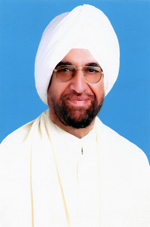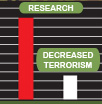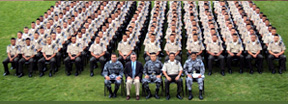This article was published on 08 November 2002 by IndianArmedForces.com (the publication closed – July 2006). Also reprinted by India Defence Consultants. Italian translation.![]()
Fighting Terrorism in India
By Maj. Gen. Kulwant Singh (Retd.) and Dr. David Leffler
Terrorism is not an easy problem to solve. India has been fighting terrorism for over half a century. Since independence in 1947, the eastern states have been under the spell of insurgents, abetted by foreign countries. The disputed region of Kashmir is a powder keg, threatening to explode into conventional and possibly nuclear war any day. A viable solution may lie in India’s past-ancient Vedic knowledge that was scientifically validated in the 20th century. Now, in the 21st century, India’s ancient method of preventive defense, a form of defense called “invincible,” promises to end terrorism and conflict and set an example for the rest of the world. Is India ready to revive its illustrious past?
India has fought four major wars over the problem of the disputed POK (Pakistan Occupied Kashmir). Pakistan is unlikely to be able to win a conventional war against India. For this reason, Pakistan has allegedly resorted to sending terrorists into Kashmir, calling them freedom fighters. This holds true throughout the world: one side’s terrorist is another side’s freedom fighter. Globally, the impact of terrorism has been increasing since al-Qaeda formed alliances with existing terrorist organizations. The rise of tensions and the looming threat of nuclear war between India and Pakistan has triggered a mass exodus of foreign nationals from India as well as Pakistan.
Like many other countries, India has fought terrorism through a dynamic approach, i.e., with weaponry and military personnel. Despite its long-term military experience fighting terrorists, India is still losing the war. Terrorists continue to increase in number. Adding to the fray of foreign-based terrorists, new organizations are emerging, like the Peoples War Group (PWG). The number of such organizations and cadres who have joined them is alarming. Even with fully equipped police and para-military forces, India will not be able to completely control them. Even more alarming, defence experts predict that it is just a matter of time before terrorists attack with weapons of mass destruction which may be handheld and easy to transport and conceal.
Tensions between India and Pakistan rise and fall, and frequently, both are poised for war. If war starts, India’s strategy, as announced so far, is for a “limited offensive” to stop terrorism. The term “limited offensive” itself is misleading, as it cannot be quantified. Does it imply limiting effort in the employment of forces, the areas of offensive, use of weapon systems and so on? In any case, India’s leaders may want it to be limited, but this cannot dictated to its opponents. In all probability, once war starts, it will not be limited.
Can India eliminate terrorism by deploying military forces, as it has for the last 50 years? Again and again, history shows that the answer is “no.” Terrorism is a human problem. Therefore, it requires a human solution. The underlying cause of terrorism, war, conflict as well as other types of social violence, is accumulated social stress.
If the collective social stress driving terrorism could be prevented, such negative problems would cease. Thus, no collective stress-no terrorism, and no war.
A silent approach to achieve this prevention ideal is described in the Vedic literature. Heyam duhkham anagatam (Yog-Sutra, 2.16): “Avert the danger before it arises.”
The Yog-Sutra, 2.35 also affirms Tat sannidhau vairatyagah: “In the vicinity of Yogic influence-unifying influence, integrating influence, coherent and harmonious influence-conflicting tendencies do not arise.” These ancient principles applied in the past, and they apply today.
According to Vedic tradition, conflict resulted from ignorance-ignorance of how to prevent the build-up of collective stress. For example, the Ramayana stated that “…ignorance will have no access within eight miles from [the Yogi’s hermitage].
“The Ramayana also described the ancient city of Ayodhya. “Ayodhya” means “the city none can challenge in warfare.” Certainly, Ayodhya relied on the conventional defence technologies of its time. For instance, “It was enclosed by strong fortifications and a deep moat, which no enemy, by any expedient whatsoever, could penetrate.” Also, “Ayodhya abounded in warriors undefeated in battle, fearless and skilled in the use of arms, resembling lions guarding their mountain caves.” However, the descriptions of the enlightened, stress-free life of the inhabitants of Ayodhya may indicate that its first line of defense was the city’s freedom from collective stress. According to the Ramayana, this low stress level, based on life in harmony with Natural Law, made Ayodhya worthy of its name.
Could this ideal of preventive defence again be accomplished in India? Vedic scholar and physicist Maharishi Mahesh Yogi revived the practical components of the silent approach of Invincible Defence Technology – he calls them the Transcendental Meditation (TM) and TM-Sidhi program. These human resource-based technologies need not require or involve religious belief and practices. These meditation techniques have been practiced by members of many faiths worldwide. Extensive scientific research documents the ability of the TM and TM-Sidhi program to dissolve stress on the individual and collective levels. India could use this nourishing and non-destructive Invincible Defence Technology to reduce tensions, thereby preventing conflicting tendencies that drive terrorism.
The operative part of Invincible Defence Technology requires having a Prevention Wing of the military. This wing would comprise about 2-3% of the armed forces. The rest of the military would carry on with their usual duties. The Prevention Wing of the military would create societal coherence by practicing the TM and TM-Sidhi program in large groups morning and evening. Their collective practice would produce positive benefits for both themselves and their adversaries. Peaceful overtures would increase from all sides.
Similar coherence-creating groups have been deployed in many war zones and conflict prone areas with great success. Extensive scientific research indicates that when 1% of the population (i.e., a city), or the square root of 1% of the population (i.e., a nation) practices the more advanced TM-Sidhi program in a group, a “field effect” is created.
This effect is called the “Maharishi Effect” by scientists. Over 50 carefully controlled studies have documented and validated positive social trends such as reduced conflict and lowered crime rate. These studies have been scrutinized and published in respected peer-reviewed journals such as Social Indicators Research, Journal of Conflict Resolution, the Journal of Mind and Behavior and Journal of Crime and Justice.
This coherence-creating effect has also been documented on a global scale. When large assemblies of practitioners of the TM-Sidhi program exceeded the Maharishi Effect threshold for the world (about 7,000 at that time) during the years 1983-1985, international conflict decreased 32%, terrorist casualties decreased 72% and violence was reduced in other nations without intrusion by other governments.
Thus, the deployment of a Prevention Wing of the Military by India could be a force multiplier. It strengthens both approaches of defence-the dynamic approach of weaponry and military personnel, and the silent approach of Invincible Defence Technology. India’s defence will be perfect, or invincible, when both these approaches are combined.
India cannot solve the problem of terrorism by standard military means alone. It also needs a silent approach, which will help people focus more on peaceful means of settling differences. India’s Vedic heritage offers the ideal means to fight terrorism and prevent war. India needs to deploy a Prevention Wing of the Military immediately for lasting peace.
Editor’s Note: Articles about Invincible Defence Technology, published in Defence India, Defense Review, India Defence Consultants, Indian Defence Review, Indian Strategic Review, The Modern Tribune, The Daily Excelsior, Defence Talk, Security and Political Risk Analysis Bulletin, The Seoul Times, Aljazeera Magazine, PakTribune, Congo Forum, Sri Lanka Guardian, Pakistan Daily, The Bottom Line, Arab News, Middle East Online, Hi Pakistan, Soldier of Africa, Frontier India Strategic & Defense, Sentinel Review, Congo Watch, Beirut-Online, India Defence Consultants, The Pakistani Spectator, Senegambia News, Fiji Daily Post, News From Bangladesh, Muslim, Intent, United News Network, News Wing, Muslim World Today, Sinhala, MEPeace, Southern Asian Outlook, Northern News Lines, Sudan Watch, Blitz, New Age Islam, The Earth Times, Newstrack India, Uganda Watch, The Morung Express, Chowk, and Islam And Muslims are available at: http://davidleffler.com/links-worldwide.
 |
Maj. Gen. (Dr.) Kulwant Singh, UYSM, Retd. received his Ph.D. and M.Sc. in Defence Studies from Chennai University. He also has a postgraduate diploma in Human Resource Development from Indira Gandhi National Open University (IGNOU) in New Delhi. Dr. Singh has a postgraduate diploma in Management from the Regional College of Management and Technology (RCMT). He qualified for the prestigious Higher Command Course at College of Combat and is a graduate of the Defence Service Staff Collage. He fought in combat and led India’s fight against India’s intransigent terrorism problem for nearly 30 years. Maj. Gen. Singh was awarded the Uttam Yudh Sewa Medal, the second highest decoration for senior officers during operations in Sri Lanka as part of IPKF (Indian Peace Keeping Force). Today he is leading an international group of generals and defense experts that advocates Invincible Defence Technology. Dr. Singh lives in New Delhi, India. |
 |
Dr. David Leffler received his Ph.D. on the topic of Invincible Defence Technology from Union Institute & University. His other academic degrees include: a B.A. in Education, an M.A. in the Science of Creative Intelligence from Maharishi University of Management and an M.M. in Education from New Mexico State University. He was a member of the U.S. Air Force for eight years. Dr. Leffler is the Executive Director at the Center for Advanced Military Science (CAMS) at Maharishi University of Management. He also serves as a Peer Member at The Union Institute and is a member of the U.S. Naval Institute. Dr. Leffler has given presentations on Invincible Defence Technology at the Russian Air Force Academy, the Russian Academy of Sciences, and defense-related institutions in the United States. |
© 2002 David R. Leffler and Kulwant Singh. All rights reserved.







